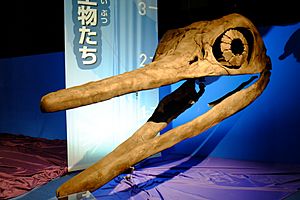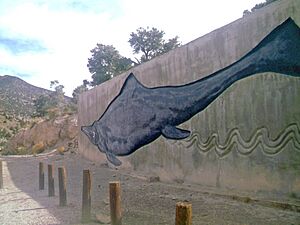Shonisaurus facts for kids
Quick facts for kids Shonisaurus |
|
|---|---|
 |
|
| Restored skull | |
| Scientific classification | |
| Genus: |
Shonisaurus
|
| Species: |
popularis
|

Shonisaurus was a giant sea reptile, the biggest ichthyosaur ever found! It was also the largest extinct marine animal discovered so far. Its fossils were first found in Nevada, USA, and later in British Columbia, Canada. These fossils date back to the Upper Triassic period.
Contents
Meet Shonisaurus: A Giant Discovery
Fossils of Shonisaurus were first found in a huge area in Nevada in 1920. About 30 years later, scientists started digging them up. They found the remains of 37 very large ichthyosaurs. These amazing creatures were named Shonisaurus, which means "Lizard from the Shoshone Mountains."
Shonisaurus lived a very long time ago, about 216 to 203 million years ago. One type, S. popularis, grew to about 15 meters (50 feet) long. That's as long as a school bus! Another, even longer, fossil was later identified as a different animal called Shastasaurus.
Shonisaurus had a long, pointed mouth. It only had teeth at the very front of its mouth. It had a big body, a bit like a whale, and a long snout, like a dolphin. Its flippers were longer and thinner than those of other ichthyosaurs. These special features suggest that Shonisaurus might have been a unique branch of the ichthyosaur family tree.
Where Shonisaurus Fossils Are Found
The first type of Shonisaurus discovered, S. popularis, became the official state fossil of Nevada in 1984. Digging for these fossils began in 1954. Scientists like Charles Camp and Samuel Welles from the University of California, Berkeley led these important excavations. Camp continued this work through the 1960s.
You can see the Nevada fossils at the Berlin–Ichthyosaur State Park in Nevada, USA. The park has several Shonisaurus popularis fossils that are still in the ground, just as they were found. The park also has the old "ghost town" of Berlin from the early 1900s. It is about 150 miles (240 km) east of Reno.
In the 1990s, scientists found S. sikkanniensis in British Columbia, Canada. This made S. popularis the smaller of the two Shonisaurus species. There's also an ichthyosaur found in the Himalayan mountains, called Himalayasaurus, which might be the same animal as Shonisaurus.
The Huge Shonisaurus from Canada
The Shonisaurus found in British Columbia, named Shonisaurus sikkanniensis, was much bigger. It is estimated to have been about 21 meters (69 feet) long! That's even longer than a tennis court. It also had a different shoulder blade shape and longer bones in its back.
Scientists believe that only young S. sikkanniensis had teeth. Adult Shonisaurus sikkanniensis likely had no teeth at all. This suggests that their diet changed as they grew older. These fossils were found in rocks that formed in deep ocean waters.
What Did Shonisaurus Eat?
Shonisaurus had a slender skull and only a few teeth at the front of its mouth. These features tell us a lot about how it ate. They are similar to modern whales that eat squid, like the pilot whale and sperm whale. This suggests that Shonisaurus probably hunted and ate soft-bodied prey, such as squid or other similar creatures, in the ancient oceans.
Images for kids
See also
 In Spanish: Shonisaurus para niños
In Spanish: Shonisaurus para niños





